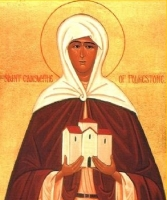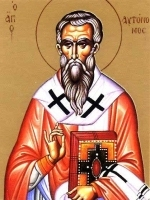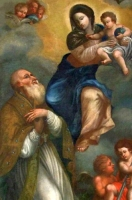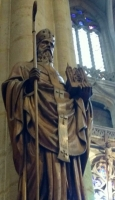St. Sacerdos of Lyon
Feastday: September 12
Death: 551
Also known as Sardot and Serdon, bishop of Lyons. He presided over the Council of Orleans in 549 and served as a chief councilor to King Childebert I of Paris.
Sacerdos of Lyon in St Pauls church, Lyon.
Saint Sacerdos (Sardot or Serdot) of Lyon (487 – 552[1]) is a French saint[2] whose Feast Day is 12 September.[3] He was Archbishop of Lyon, France from 544 to 552.
Life
Sacerdos was the son of St. Rusticus, Archbishop of Lyon, and his wife.
Sacerdos was a distinguished Bishop of Lyons who He presided at the Fifth Council of Orléans in 549[4][5] He is thought to have built the Église Saint-Paul,[6] and the Church of Saint-Eulalia, which later became the Église Saint-Georges.[7]
His son Saint Aurelianus was an Archbishop of Arles. His nephew Nicetius of Lyon (Nizier) succeeded him as Archbishop of Lyon.
He died at Paris, King Childebert, whose adviser he had been, assisting at his deathbed. His remains were transported to Lyons,[8] where he was buried in the church of the Apostles, later known as the Church of Saint Nicholas
Saint Guy of Anderlecht
அன்டர்லேச்ட் நகர் புனிதர் கய்
(St. Guy of Anderlecht)
அன்டர்லேச்ட் நகரின் எளிய மனிதன்:
(The Poor Man of Anderlecht)
பிறப்பு: கி.பி. 950
இறப்பு: கி.பி. 1012
அன்டர்லேச்ட், பெல்ஜியம்
(Anderlecht, Belgium)
ஏற்கும் சமயம் :
ரோமன் கத்தோலிக்க திருச்சபை
(Roman Catholic Church)
பாதுகாவல்:
அன்டர்லேச்ட் நகர் (Anderlecht), பெல்ஜியம் (Belgium), வெறி நாய்களுக்கு எதிராக, நாய்க்கடிக்கு எதிராக, மணமாகாத ஆடவர், வலிப்பு நோயாளிகள், கொம்புகள் கொண்ட மிருகங்கள், கூலி வேலையாட்கள், வெளிப்புற கட்டிடங்களின் பாதுகாவல், தொழுவம், கொட்டகை, உழைக்கும் குதிரைகள், தேவாலயங்களின் புனிதப் பாத்திரங்கள் மற்றும் அங்கிகள் முதலானவைகளின் பொறுப்பாளர்.
நினைவுத் திருநாள்: செப்டம்பர் 12
“கைடோ” (Guido) என்றும், “கைடோன்” (Guidon) என்றும், “லகேன் நகர வை” (Wye of Láken) என்றும் அழைக்கப்படும் புனிதர் “கய்”, ஒரு கிறிஸ்தவ புனிதர் ஆவார். இவர், பொதுவாக, “அன்டர்லேச்ட் நகரின் எளிய மனிதன்” (Poor Man of Anderlecht) என்றும் அனைவராலும் அழைக்கப்படுகிறார்.
ஏழைப் பெற்றோருக்குப் பிறந்த புனிதர் “கய்”, “லகேன்” (Laken) நகரிலுள்ள அன்னை மரியாளின் தெய்வ இல்லத்தின் புனிதப் பாத்திரங்கள், அங்கிகள் முதலானவைகளின் பொறுப்பாளர் பணியை ஏற்கும்வரை விவசாய வாழ்க்கையே வாழ்ந்தார். ஆலயத்தை பெருக்கிச் சுத்தப்படுத்துதல், திருப்பலி பீடத்தை அலங்கரித்தல், திருப்பலி பீடத்துக்கான துணிமணிகள் மற்றும் மத குருமார்களின் உடைகளைப் பராமரித்தல், திருப்பலி பூஜை மற்றும் மாலை நேர செபங்களுக்காக ஆலய மணியையடித்தல், ஆலயத்தில் செய்யப்படும் அலங்காரம் மற்றும் பூக்கள் ஏற்பாடு செய்தல் போன்ற பணிகளை செய்துவந்தார்.
மேற்கண்ட ஆலய பணிகளை, ஒரு வணிக முயற்சியில் முதலீடு செய்ய தூண்டப்படும்வரை செய்துவந்தார். ஒருமுறை, அவர் முதலீடு செய்த சரக்குக் கப்பல் துறைமுகத்தில் மூழ்கியபோது, தமது பேராசைக்காகவே தாம் தண்டிக்கப்பட்டதாக என்று “கய்” நம்பினார். நோன்பு மற்றும் பரிகார முயற்சியாக முதலில் ரோம் நகருக்கு திருயாத்திரை சென்றார். பின்னர், “எருசலேம்” (Jerusalem) நகரில் பிற திருயாத்திரிகர்களுக்கு வழிகாட்டியாக பணியாற்ற சென்றார். அங்கிருந்து தமது சொந்த ஊருக்கு திரும்பும் வழியில் கய் மரித்தார்.
புனிதர் கய், “அன்டர்லேச்ட்” நகர் (Anderlecht), பெல்ஜியம் (Belgium), வெறி நாய்களுக்கு எதிராக, நாய்க்கடிக்கு எதிராக, மணமாகாத ஆடவர், வலிப்பு நோயாளிகள், கொம்புகள் கொண்ட மிருகங்கள், கூலி வேலையாட்கள், வெளிப்புற கட்டிடங்களின் பாதுகாவல், தொழுவம், கொட்டகை, உழைக்கும் குதிரைகள், தேவாலயங்களின் புனிதப் பாத்திரங்கள், அங்கிகள் முதலானவைகளின் பொறுப்பாளர் ஆகியவற்றின் பாதுகாவலர் ஆவார்.
இவரது கல்லறை, ஒரு குதிரை அதனை உதைத்தபோது காணப்பட்டது என்று கூறப்படுகின்றது. 1914ம் ஆண்டு, முதல் உலகப் போர் துவங்கும்வரை, “பிரபான்ட்” (Brabant) நகரின் குதிரை வண்டி ஓட்டுனர்கள், “அன்டர்லேச்ட்” (Anderlecht) நகருக்கு வருடாவருடம் திருயாத்திரை செல்வதை வழக்கமாகக் கொண்டிருந்தனர்
Also known as
• Guido of Anderlecht
• Guidon of Anderlecht
• Poor Man of Anderlecht
• Wye of Láken
Profile
Born in poverty, he was trained in religion by pious parents. For many years he embraced poverty as God's will for him, and spent his time caring for the poor and sick. When he worked the fields, an angel would sometimes man the plow so that Guy could pray without distraction. He hung around the local church so much the priest made him the parish sacristan; Guy then lived in the church, and often spent all night in prayer.
A merchant from Brussels, Belgium either decided to give the boy a leg up in the world, or figured that Guy was a bumpkin who could be defrauded; versions vary. Either way, he offered Guy a part share in a new project that could make him rich. In the first ocean-going expedition in the project, the ship involved sank; Guy took it as a sign that he was right to begin with, and returned to his old life of poverty.
As penance for his bout of greed, Guy made a pilgrimage on foot to Rome, Italy then to Jerusalem where he worked for a while as a guide to pilgrims, then back to Brussels. Though he never joined any order or house, he vowed chastity, and devoted most of his time to prayer, and work as a sacristan.
Many post-mortem miracles attributed to him. An annual festival grew up in the area around his grave, with most of the activities involving horses and the people who work with them because his grave, which was lost for years, was uncovered by a horse.
Born
c.950 at Anderlecht, Belgium
Died
• 1012 at Anderlecht, Belgium of exhaustion and related natural causes
• his grave was forgotten for years until uncovered by a horse
• relics translated to a nearby church in 1076
• due to wars, his relics were moved and hidden in several places over the years
• relics destroyed by Protestants in the 18th century
Patronage
• Anderlecht, Belgium
• epileptics; against epilepsy
• rabies; rabid animals; against hydrophobia or rabies
• animals with horns
• bachelors
• convulsive children
• farmers
• laborers, workers
• protection of outbuildings, sheds and stables
• sacristans; sextons
• work horses
Representation
• peasant praying while an angel plows a nearby field
• peasant with a book
• pilgrim with a book
• pilgrim with hat, staff, rosary, and an ox at his feet
Saint Franciscus Ch'oe Kyong-Hwan
Also known as
• Choe Gyeong-Hwan
• Peuranchiseuko
Additional Memorial
20 September as one of the Martyrs of Korea
Profile
Raised in a prosperous Christian family; his grandfather was an early convert, and brought his family into the faith. When the priests were all executed or kicked out of the country, the family began to be harassed by locals who were returning to paganism, and they moved to the capital city of Seoul, Korea. There they became involved in some legal entanglements, lost most of their wealth, moved to a village on Mount Suri, and became tobacco farmers. Other Christian families, seeking support in numbers, moved near them, and a faithful Catholic community developed. Franciscus, by this time married and a father, served as catechist, teaching the faith to people in his home at night; he did not have a theological education, but had access to several spiritual texts, and was a man who loved God. In 1836, his son, Thomas Yang-eop was chosen by Saint Pierre Maubant of the Society of Foreign Missions of Paris to study for the priesthood in Macao. Francicus and Maria were overjoyed, and considered the entire family to be blessed.
In 1839, state-sponsored persecution of Christians began again in earnest. Franciscus collected money to support those in prison, who were left by the state to fend for themselves, and gave Christian burial to those who died for their faith. Back home, he gathered all the religious objects in the village and buried them so that they would not be defiled, and could possibly be used later; he kept his catechism texts, and continued studying and teaching. Franciscus, his family and about 40 of his fellow villagers were arrested on the night of 31 July 1839 for the crime of being Christian, and forced to march to Seoul. There he was ordered to renounce Christianity; when he refused, he was imprisoned; he was in the same prison as Saint Lawrence Mary Joseph Imbert. Between torture and beating sessions over the next several weeks, he spent his time in prayer and catechesis to other prisoners. Martyr.
His wife Maria, who watched him die, renounced Christianity; she later reverted to the faith, and was eventually beheaded herself. Their son Thomas was ordained in 1849 and returned to Korea to serve as missionary in remote villages.
Born
1805 in Taraekkol, Hongjugun, Ch'ungch'ong, South Korea
Died
in the early morning of 12 September 1839 in prison in Seoul, South Korea from injuries received during a series of beatings
Canonized
6 May 1984 by Pope John Paul II in Youido Square, Seoul, South Korea
Saint Ailbe of Emly
புனித எல்பே St. Ailbe
பிறப்பு
5 ஆம் நூற்றாண்டு
இறப்பு
528
பாதுகாவல்: கேஷல் Cashel மற்றும் எமிலி Emly மறைமாவட்டங்களுக்கு பாதுகாவலர்
இவர் அயர்லாந்து நாட்டில் மறைபோதகராக பணியாற்றினார். பின்னர் ஆயராகவும் பொறுப்பேற்றுள்ளார். இவர் புனித பாட்ரிக்(Patrick) சபையை சார்ந்தவர். இவர் அல்பேயுஸ்(Albeus) என்ற பெயரால் அழைக்கப்பட்டதாக சில வரலாறுகள் கூறுகின்றது. ஜெர்மனியிலுள்ள முன்ஸ்டர் (Münster) என்ற மறைமாவட்டத்திலிருந்த அரசன் ஒருவரால் அயர்லாந்துக்கு அனுப்பப்பட்டார்.
இவரிடம் பல கொடுமையான மிருகங்கள் அன்பை நாடி இவரிடம் வந்து செல்லும் என்று சொல்லப்படுகின்றது. அப்போது ஒரு நாள், ஒரு ஓநாய் வந்து இவரின் மார்பில் படுத்துகொண்டு பல மணிநேரம் கழித்தே, அவரைவிட்டு சென்றாக சொல்படுகின்றது. இவர் அயர்லாந்தில் பலரை திருமுழுக்கு கொடுத்து மனந்திருப்பி உள்ளார். இவர் அயர்லாந்து நாட்டு சட்ட திட்டங்களுக்கு எதிராக செயல்பட்டதாக கூறப்பட்டு, அந்நாட்டு அரசால் கண்டிக்கப்பட்டுள்ளார். அப்போதும் கூட இவர் தனது போதனைகளில் கிறிஸ்துவை முன் வைத்து மறைப்பணி ஆற்றியுள்ளார். இதனால் அந்நாட்டு அரசாங்கங்கள் இவரைக்கொண்டு சென்று, அடர்ந்த காட்டு பகுதியில், விலங்குகளிடையே விட்டுள்ளனர். அச்சமயத்தில் கூட பொறுமையைக் கடைபிடித்து, எளிமையான வாழ்ந்து, தன்னை நாடி வந்த மக்களுக்கு மறையுரையாற்றி அவர்களின்மேல் கரிசனை காட்டி வந்துள்ளார். இவர் அயர்லாந்து மக்களை தன் இதயத்தில் வழிநடத்தினார்.
Also known as
• Ailbhe, Albert, Albeo, Albeus, Elvis
• The Patrick of Munster
Profile
Disciple of Saint Patrick. Effective evangelist throughout Ireland with the support of King Aengus of Munster. Noted for his charity and his excellent preaching. Little else is known for sure, but many stories and much speculation have attached to Ailbhe. He may have been the first bishop of Emly, Ireland. He may have founded a monastery at Killeaney, Inishmore, Ireland. One old story stays that he was born to parents so poor that they were unable to feed him, and abandoned him in the deep woods; a she-wolf, running from hunters, settled beside the baby and suckled him as one of her cubs; the hunters found them, saved the baby and spared the wolf.
Born
Irish
Died
c.541 of natural causes
Patronage
• Cashel, Ireland, diocese of
• Cashel and Emly, Ireland, archdiocese of
• Emly, Ireland, diocese of
• Munster, Ireland
• wolves
Representation
• bishop holding the cathedral of Cashel, Ireland
• with a wolf or pack of wolves
Feast of the Holy Name of Mary
அதிதூய மரியாளின் புனிதப் பெயர்
(Most Holy Name of the Blessed Virgin Mary)
திருவிழா நாள்: செப்டம்பர் 12
துருக்கி நாட்டுப் படையானது கிறிஸ்தவ நாடுகளின் மீது எப்போது வேண்டுமானாலும் படையெடுத்து வந்து போர்தொடுக்கலாம் என்றதொரு அபாயச் சூழல் நிலவியது. இதை அறிந்த போலந்து நாட்டு மன்னன் ஜான் சொபீஸ்கி (John Sobikeski) என்பவர் தன்னுடைய படைகளைத் போருக்குத் தயார்படுத்தினார். பின்னர் தன்னுடைய படையை மரியாவின் புனித பெயருக்கு ஒப்புக்கொடுத்து ஜெபித்து, போருக்குச் சென்றார். கி.பி. 1683ம் ஆண்டு, செப்டம்பர் 12ம் நாள், வியன்னாவில் இரு நாட்டுப் படைவீரர்களுக்கும் இடையே நடைபெற்ற போரில் ஜான் சொபீஸ்கியின் தலைமையிலான கிறிஸ்தவப் படையானது, துருக்கி நாட்டுப் படையை வெற்றிகொண்டது. அன்றிலிருந்தே மரியாளின் புனித பெயருக்கு வணக்கம் செலுத்தும் முறையானது வழக்கில் வந்தது.
வரலாற்றுப் பின்னணி:
மரியாளின் புனித பெயருக்கு வணக்கம் செலுத்தும் முறை, கி.பி. 15ம் நூற்றாண்டிலிருந்தே வழக்கில் இருந்து வந்திருக்கிறது. ஆனால் மேலே சொல்லப்பட்ட நிகழ்விற்குப் பின்னர் இவ்வழக்கம் மக்கள் மத்தியில் இன்னும் பிரபலமாகத் தொடங்கியது. ஜான் சொபீஸ்கி தலைமையிலான கிறிஸ்தவப் படை துருக்கி நாட்டுப் படையை வெற்றிகொண்ட பிறகு, அப்போது திருத்தந்தையாக இருந்த பதினோறாம் இன்னொசென்ட் என்பவர் ஒவ்வொரு ஆண்டும் செப்டம்பர் மாதம் 12ம் நாள், மரியாளின் புனித பெயருக்கு விழா எடுத்துக் கொண்டாடப் பணித்தார். அன்றிலிருந்து இன்றுவரை அப்படியே கொண்டாடப்பட்டு வருகின்றது.
மரியாளின் புனித பெயருக்கு இருபதுக்கும் மேற்பட்ட அர்த்தங்கள் இருப்பதாக அறிஞர்கள் பெருமக்கள் சொல்வார்கள். அவற்றில் ஒருசிலவற்றை மட்டும் நம்முடைய கவனத்தில் எடுத்துக்கொண்டு சிந்தித்துப் பார்ப்போம். விவிலிய அறிஞரான எரோனிமுஸ் என்பவர் மரியாள் என்றால் கடலின் ஒரு துளி (Drop of the Sea) என்று சொல்வார். அது எப்படியென்றால் கடல் என்பது கடவுளோடு உருவகப்படுத்தப்படுகின்றது. கடல் கடவுளாக உருவகப்படுத்தப்படும் பட்சத்தில் அதில் ஒரு துளி மரியாள் என்று சுட்டிக்காட்டுவார். மேலும் அவர் மரியாள் என்பதற்கு இறைவி என்றும் சுட்டிக்காட்டுவார். இன்னும் ஒருசிலர் மரியாள் என்பதற்கு அழகு நிறைந்தவள், அன்பு வடிவானவள், உயர்த்தப்பட்டவள் என்றும் பொருள் கூறுவர்.
விவிலியத்தில் ஆண்டவர் இயேசுவின் திருப்பெயருக்கு எவ்வளவு வல்லமை இருக்கின்றது என்பதை பல இடங்களில் வாசிக்கின்றோம். “நீங்கள் என் பெயரால் தந்தையிடம் கேட்பதை எல்லாம் அவர் உங்களுக்குத் தருவார்” (யோவா 16:23) என்று இயேசு கிறிஸ்து தன் பெயரால் நடக்கும் வல்ல செயல்களைக் குறித்துப் பேசுகின்றார். “வெள்ளியும் பொன்னும் என்னிடமில்லை; என்னிடம் உள்ளதை உமக்குக் கொடுக்கிறேன். நாசரேத்து இயேசுவின் பெயரால் எழுந்து நடந்திடும்” (திப 3:6) என்று தலைமைத் திருத்தூதரான தூய பேதுரு கால் ஊனமுற்றவரிடம் சொல்ல, அவர் எழுந்து நடப்பதைப் படிக்கின்றோம். தூய பவுல் இயேசுவின் திருப்பெயர் எத்துணை மகிமை வாய்ந்தது என்பதைக் குறித்துப் பேசுகின்றார். “எனவே கடவுளும் அவரை (இயேசுவை) மிகவே உயர்த்தி, எப்பெயருக்கும் மேலான பெயரை அவருக்கு அருளினார். ஆகவே இயேசுவின் பெயருக்கு விண்ணவர், மண்ணவர், கீழுலகோர் அனைவரும் மண்டியிடுவர்” என்று கூறுகின்றார் (பிலி 2: 9-10) இவ்வாறு இயேசுவின் திருப்பெயரால் ஆகும் வல்ல செயல்களை, அதனுடைய மகிமையை நாம் அறிந்துகொள்கிறோம்.
இயேசுவின் திருப்பெயரைப் போன்றே, மரியாளின் புனிதப் பெயருக்கும் வல்லமை இருக்கின்றது என்பதை வரலாறு நமக்கு எடுத்துக்கூருகின்றது. தூய பிரிஜித்துக்கு மரியாள் கொடுத்த காட்சியில், அலகையின் கூட்டம் மரியாளின் பெயரை யாராவது உச்சரிக்கக் கேட்டவுடன் மிரண்டு ஓடுவதையும், வானதூதர்கள் விரைந்து வந்து உதவுவதையும் படித்தறிக்கின்றோம். தூய அம்ரோசியார், “மரியாளின் இனிய நாமம் எனது உள்ளத்தின் ஆழத்தில் மீட்பின் தைலமாக இருக்கின்றது” என்று சுட்டிக்காட்டுவார். இன்னும் இது போன்று தூயவர்களின் வார்த்தைகளைக் கொண்டு பார்க்கும்போது மரியாளின் பெயருக்கு எவ்வளவு ஆற்றல் இருக்கின்றது என்பதை நாம் உணர்ந்து கொள்ளலாம்.
‘இனிய உன் நாமம் ஒதிடல் தினமே’ என்று மரியாளுக்குப் பாடல் பாடும் நாம், அவருடைய புனித பெயரை நம்பிக்கையோடு சொல்லுகின்றபோது அதனால் வாழ்வு பெறுவோம் என்பது உறுதியான செய்தி.
கற்றுக்கொள்ளவேண்டிய பாடம்:
மரியாளின் திருப்பெயருக்கு விழா எடுக்கும் இந்த நாளில் இவ்விழா நமக்கு உணர்த்தும் செய்தி என்ன என்று சிந்தித்துப் பார்த்து நிறைவு செய்வோம்.
மரியாளின் பெயரைச் சொல்வோருக்கு, மரியாள் மகிழ்ச்சியைத் தருவார்:
தூய அல்போன்ஸ் லிகோரி தான் எழுதிய ‘மரியாளின் மாண்பு’ என்ற புத்தகத்தில் சொல்லக்கூடிய நிகழ்வு:
வயதான குருவானவர் ஒருவர் கிளி ஒன்று வளர்த்தார். அந்தக் கிளிக்கு அவர் ஒவ்வொரு நாளும் ‘மரியே வாழ்க’ என்ற திருநாமத்தை சொல்லி வளர்த்தார். அந்த கிளியும் அதனை எளிதாகக் கற்றுக்கொண்டது. ஒருநாள் அவர் அந்த கிளியை கூண்டிலிருந்து திறந்துவிட்டு, தன்னுடைய பங்களாவிற்கு முன்பாக அது நடந்து செல்லும் அழகை ரசித்துக்கொண்டிருந்தார். அப்போது திடிரென்று மேலே பறந்துகொண்டிருந்த பருந்து ஒன்று, அதன்மேல் பாய்ந்து, கிளியைத் தூக்கிச் செல்லப் பார்த்தது. அப்போது அந்தக் கிளி தனக்குத் தெரிந்த ‘மரியே வாழ்க’ என்பதைச் சொன்னது. உடனே, கிளியைத் தூக்க வந்த பருந்து தரையில் விழுந்து செத்து மடிந்தது.
மரியாளின் திரு நாமத்தினால் நமக்கு வரும் தீவினைகளும் விட்டு ஓடிவிடும் என்பதை இந்த நிகழ்வு நமக்கு எடுத்துக்கூறுகின்றது.
நாமும் மரியாளின் பெயரை நம்பிக்கையோடு உச்சரிக்கும் போது தீவினைகள் அனைத்தும் நம்மை விட்டு விலகி ஓடும் என்பது உறுதி. ஆகவே, மரியாளின் புனித பெயருக்கு விழா எடுக்கும் இந்த நாளில் நாமும் அவருடைய பெயரை நம்பிக்கையோடு சொல்வோம். அதனால் எல்லாம் நலன்களையும் பெறுவோம்.
Article
Feast of the entire Latin Church. It was first observed at Cuenca, Spain in 1513, then extended to the universal Church and assigned to its present place and rank by Pope Innocent XI in 1683 in thanksgiving to God and the Blessed Virgin for the liberation of Vienna, France and the signal victory over the Turks on 12 September 1683. It is the titular feast of the Society of Mary (Marianists) and of the Congregation of the Oblates of Mary Immaculate.
Blessed Apolinar Franco
Also known as
Apollinaris
Additional Memorials
• 10 September as one of the 205 Martyrs of Japan
• 22 May as one of the Franciscan Martyrs of Japan
Profile
Franciscan Friars Minor (Observants) priest. Missionary to Japan during the 17th century when Christianity was a capital offense. Imprisoned soon after his arrival, Apollinar spent over five years on death row during which he converted his jailers, ministered to other prisoners, and spread the Word of God.
Born
1575 in Aguilar del Campo, Palencia, Spain
Died
burned alive on 12 September 1622 at Omura, Nagasaki, Japan
Beatified
7 May 1867 by Pope Pius IX
Blessed Pierre-Sulpice-Christophe Faverge
Also known as
Brother Roger
Profile
Salesian brother, joining in 1767. Teacher. Imprisoned on a ship in the harbor of Rochefort, France and left to die during the anti-Catholic persecutions of the French Revolution. One of the Martyrs of the Hulks of Rochefort.
Born
25 July 1745 in Orléans, Loiret, France
Died
12 September 1794 aboard the prison ship Deux-Associés, in Rochefort, Charente-Maritime, France
Beatified
1 October 1995 by Pope John Paul II
Saint Eanswith
Also known as
Eanswida, Eanswythe
Profile
Born to the nobility, grand-daughter of King Ethelbert of Kent. On the coast near Folkestone, she founded the first convent in England; it was later destroyed by invading Danes.
Died
• c.640
• relics in the church of Saint Eanswith, Folkestone, England
Representation
nun wearing a crown and holding a church or fish
Blessed Ebontius of Babastro
Also known as
Ebon, Eboncio, Ponce, Poncio, Pontius
Profile
Benedictine monk in Sainte-Foi, Tomieres, France. Abbot of San Victorian, Ainsa, Aragon, Spain. Bishop of Roda de Isábena, Aragon, Spain. The see was moved to Babastro, Spain after it was re-captured from the Moors.
Born
Sarrancolin, Comminges, Haute-Garrone, France
Died
1104
Saint Autonomus
Also known as
Autonomo
Profile
Bishop. Fled to Bithynia, Asia Minor to escape the persecution of Diocletian. The people there accepted him as one of their own, and he became a great evangelist. Martyr.
Born
Italian
Died
martyred c.300 in Asia Minor
Saint Juventius of Pavia
Profile
First century evangelist. First bishop of Pavia, Italy. Worked with Saint Hermagoras of Aquileia and Saint Syrus of Pavia.
Saint Curonotus
Also known as
Curomotus
Profile
Bishop of Iconium, Asia Minor. Martyred in the persecutions of Valerian.
Died
c.258 in Asia Minor
Saint Silvinus of Verona
Also known as
Silvino
Profile
Bishop of Verona, Italy.
Died
c.550
Martyrs of Alexandria
Profile
A group of Christians martyred in the persecutions of Diocletian. We know little more than their names - Hieronides, Leontius, Sarapion, Seleusius, Straton and Valerian.
Died
drowned c.300 at Alexandria, Egypt
Martyrs of Phrygia
Profile
Three Christians who were martyred for destroying pagan idols. We know little more than their names - Macedonius, Tatian and Theodolus.
Died
burned to death in 362 in Phrygia (modern Turkey)
205 Martyrs of Japan
Thousands of people were murdered in the anti-Catholic persecutions of Japan. I have pages on each of them, but in most cases I have only found very minimal information. They are available on the CatholicSaints.Info site through these links:
• Blessed Dominic Magoshichi
• Blessed Francis of Saint Bonaventure
• Blessed Mancius of Saint Thomas
• Blessed Paul of Saint Clare
• Blessed Tomás de Zumárraga Lazcano
Martyred in the Spanish Civil War
Thousands of people were murdered in the anti-Catholic persecutions of the Spanish Civil War from 1934 to 1939. I have pages on each of them, but in most cases I have only found very minimal information. They are available on the CatholicSaints.Info site through these links:
• Blessed Fortunato Arias Sánchez
• Blessed Francisco Maqueda López
• Blessed Jaume Puigferrer Mora
• Blessed Josep Plana Rebugent
• Blessed Julián Delgado Díez
Also celebrated but no entry yet
• Our Lady of Lipa
• Gold Ring Mass
• Christopher Outers
• Daniel of Thasos
• Degenhard of Bischofsmais
• Molaise of Devenish
• Tesaurus Beccheria





























